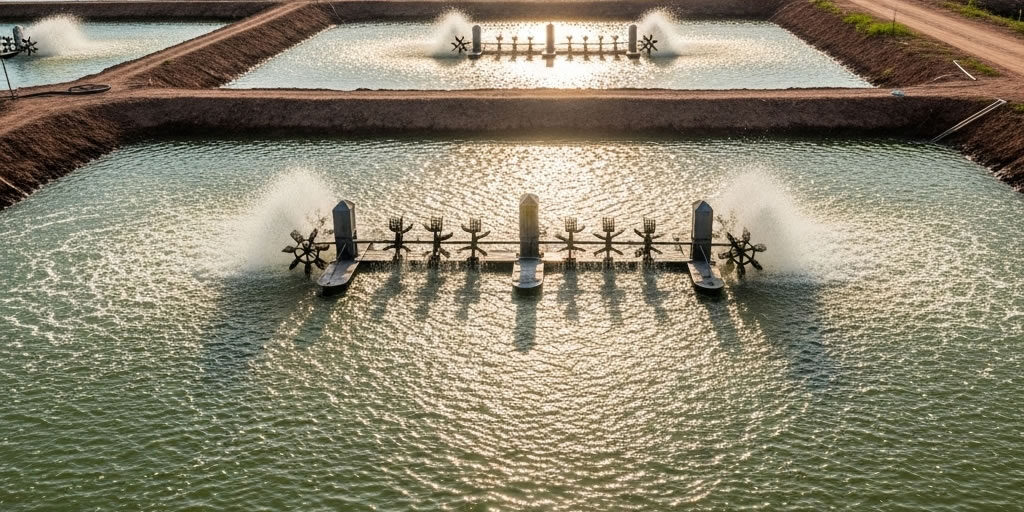- Software Gestor para Aquicultura
- (85) 2139-6730
- contato@despesca.com.br
Aeration and Water Renewal: The Definitive Guide to Maximize Production and Reduce Costs

Environmental Licensing for Aquaculture in Brazil
20/08/2025
Fish Farming: How to Calculate Initial Investment and Break-Even Point
22/08/2025The quest for high productivity in modern fish and shrimp farming invariably involves the precise management of water quality. Among the various parameters requiring constant attention, dissolved oxygen (DO) is the most critical. A deficiency can cause stress, reduced feed consumption, poor feed conversion, and, in extreme cases, mass mortality of the stock.
This is where aeration and water exchange strategies become essential. This comprehensive guide demystifies these practices, compares the available technologies, and demonstrates how proper management can not only save a crop but also significantly reduce electricity costs, one of the main financial bottlenecks of the activity.
The Vital Importance of Dissolved Oxygen
Fish and shrimp need oxygen for all their metabolic processes, from digestion to growth. In a production pond, the DO concentration fluctuates throughout the day. During daylight hours, microalgae produce oxygen via photosynthesis. However, at night, the consumption of DO through respiration by the animals, algae, and bacteria can cause levels to drop to dangerous thresholds, especially at dawn.
The demand for oxygen increases dramatically with the growth of biomass (total weight of animals in the pond), water temperature, and the amount of decomposing organic matter. Ignoring this dynamic is a risk that the farmer cannot afford to take.
Aeration Techniques: Comparison and Applications
Mechanical aeration aims to incorporate atmospheric oxygen into the water and promote circulation, homogenizing the water column and preventing anoxic (oxygen-depleted) zones at the bottom of the pond. The choice of the ideal equipment depends on stocking density, pond shape, and the available investment.
1. Paddlewheel Aerators
Considered the most popular in aquaculture, they work by creating a strong surface flow that breaks the water’s tension, promoting excellent oxygen transfer.
- Advantages: High efficiency in oxygenation and water movement, ideal for large ponds and high-biomass crops.
- Disadvantages: Higher energy consumption compared to other techniques and the need for strategic positioning to avoid “aeration shadow zones.”
- When to use: Indispensable in intensive and super-intensive farming. Power recommendations can range from 2 to over 10 HP per hectare, depending on the density.
2. Diffused Air Systems (Aerotubes)
This system uses air blowers that, through porous hoses or diffusers, release microbubbles at the bottom of the pond. The bubbles rise through the water column, transferring oxygen continuously.
- Advantages: Lower energy consumption per kilogram of oxygen transferred. Excellent for biofloc systems (BFT) as it does not break up the microbial aggregates.
- Disadvantages: Lower capacity to promote horizontal water circulation.
- When to use: Ideal for BFT systems, nurseries, net pens, and ponds where energy efficiency is a priority.
3. Airlifts
Airlifts use the injection of air at the base of a tube to promote vertical water circulation. The water from the bottom, which is poor in oxygen and rich in toxic compounds, is brought to the surface where gas exchange occurs.
- Advantages: Very low energy consumption and high efficiency in circulating and destratifying the water column.
- Disadvantages: Lower rate of direct oxygen incorporation when compared to paddlewheel aerators.
- When to use: Excellent as a complementary tool to break stratification in larger ponds and as the main circulator in biofloc systems.
Water Exchange: A Strategic Management Tool
Water exchange is a management practice used to dilute toxic compounds, such as ammonia and nitrite, and remove excess organic matter. However, it must be used judiciously.
Excessive and unplanned water exchange, in addition to the high cost of pumping, poses a serious risk to the farm’s biosecurity, potentially serving as an entry point for diseases. The decision should always be data-driven, monitoring parameters such as water transparency and nitrogen compound levels.
The Role of Technology in Decision-Making: Optimizing with Management Software
How does one know the exact moment to turn on the aerators or the need for a water exchange? The answer lies in constant monitoring and historical data analysis. It is at this point that a management software, such as Despesca, becomes an indispensable ally for the modern farmer.
A management system allows you to:
- Record and analyze water quality parameters: Generate historical graphs to identify trends and the times of greatest risk for oxygen drops. To learn more, read our article on the main water quality parameters.
- Control production costs: Record the usage time of each piece of equipment (aerators, pumps) to accurately calculate energy consumption and its impact on the final cost per kilogram produced.
- Make data-driven decisions: Replace guesswork with assertive decisions. Program equipment activation only when necessary, generating substantial energy savings without compromising the health of the crop.
- Track management actions: Keep a detailed record of all actions, including water exchanges, helping to create safer and more efficient protocols.
Conclusion: Efficiency is the Key to Profitability
The efficient management of aeration and water renewal is a combination of technique and strategy. The correct choice of equipment, an intelligent usage schedule, and judicious exchanges directly impact the health of the crop and, most importantly, the profitability of the business. The use of management technologies is the way to transform data into profitable decisions, ensuring the sustainability of aquaculture production.




